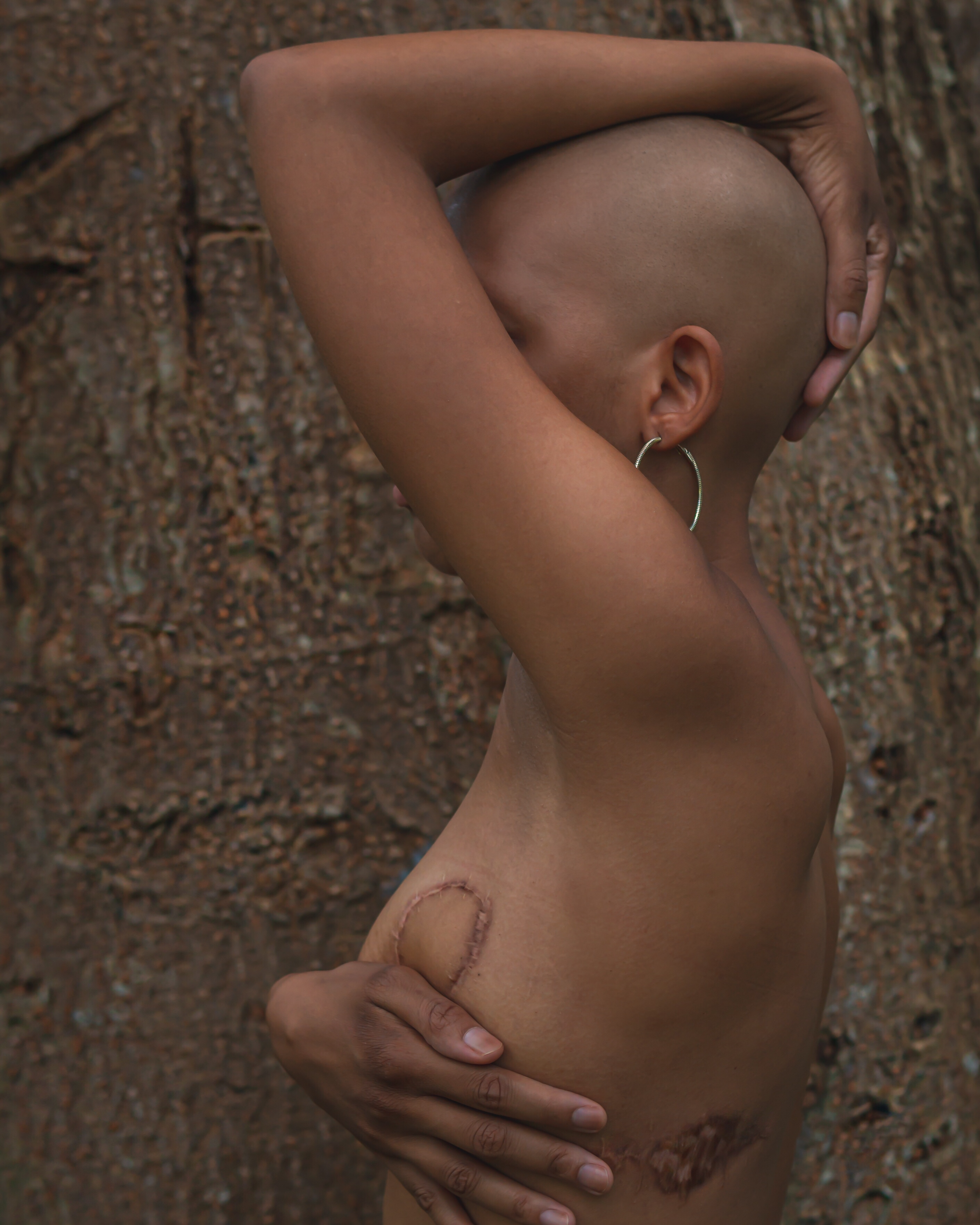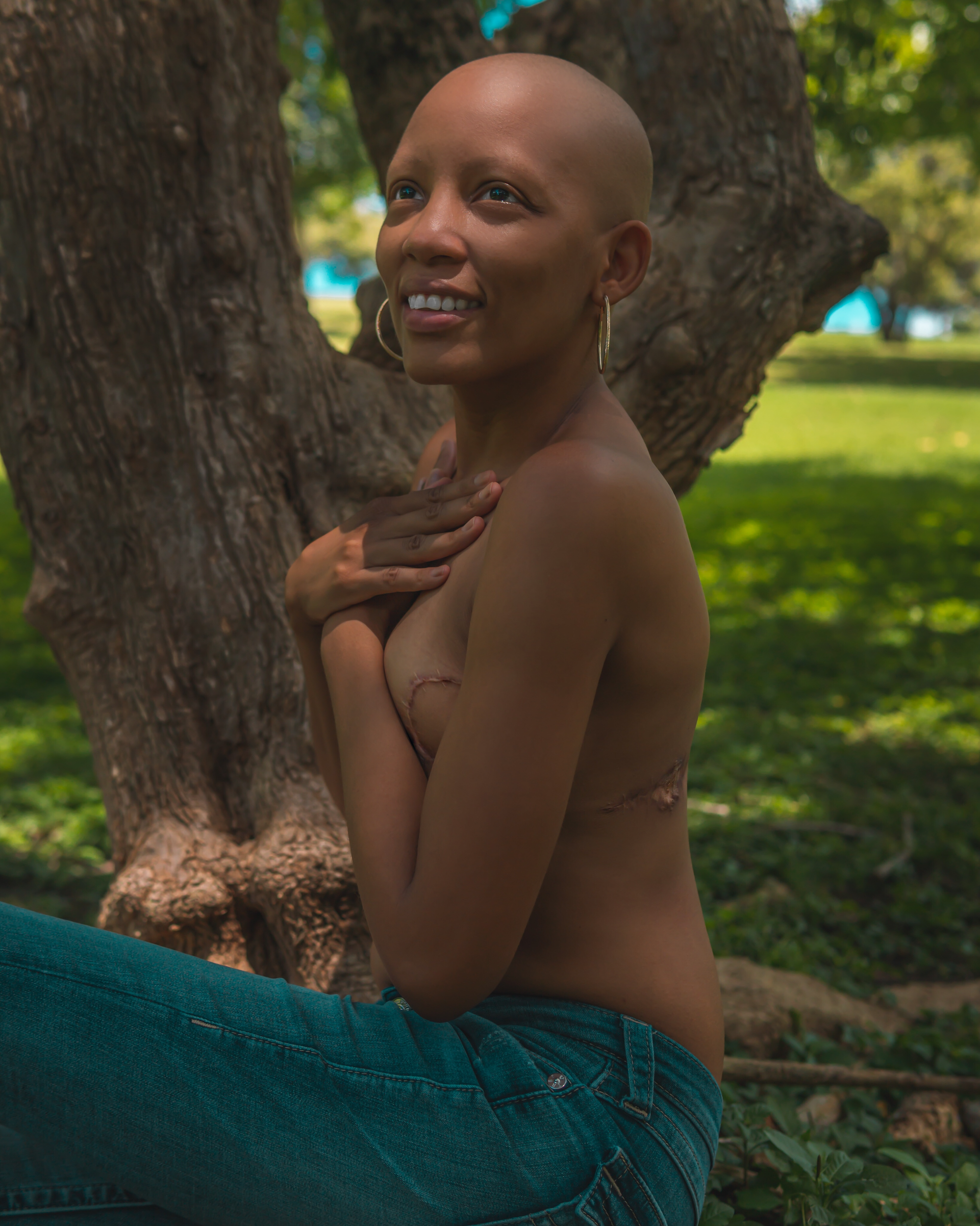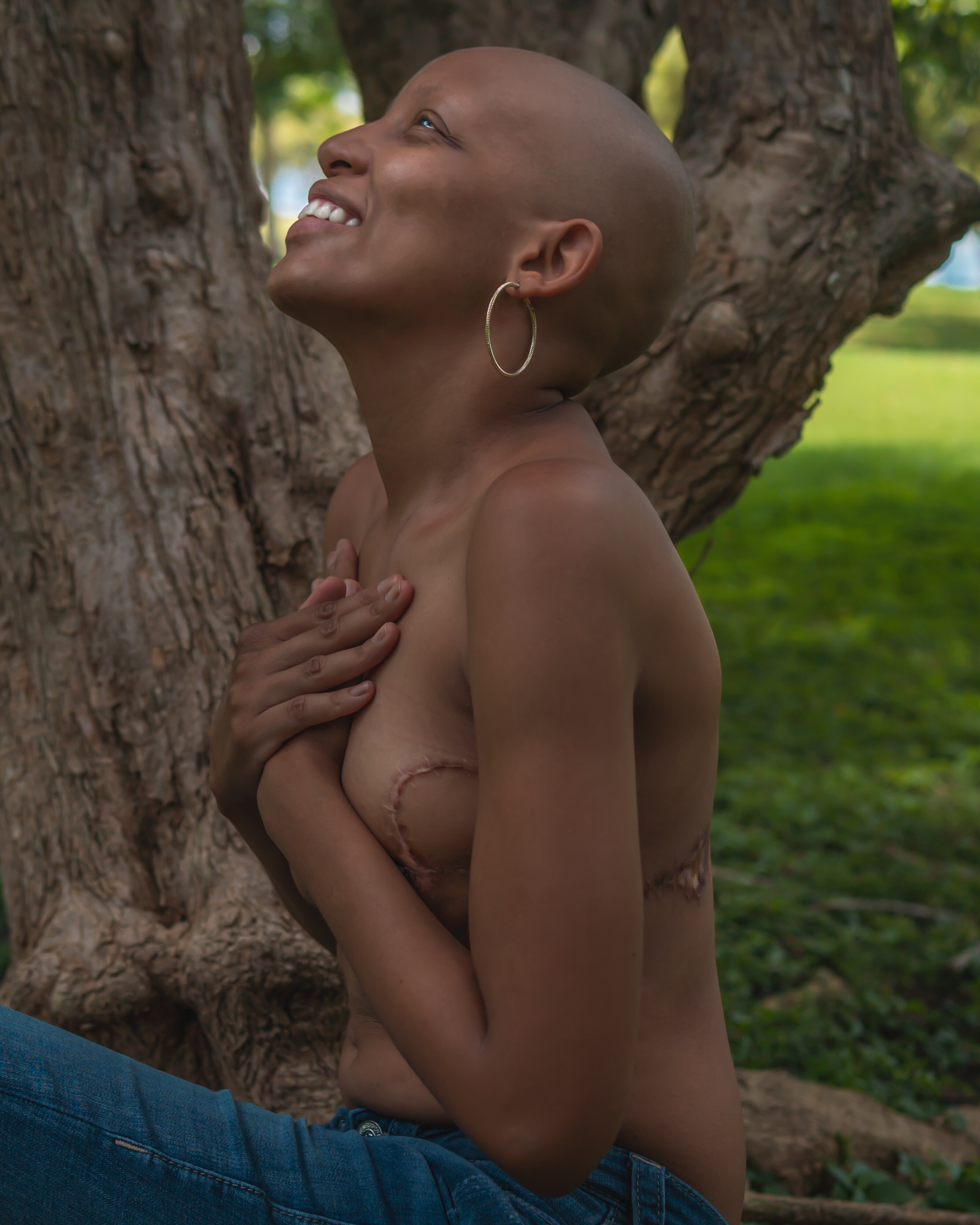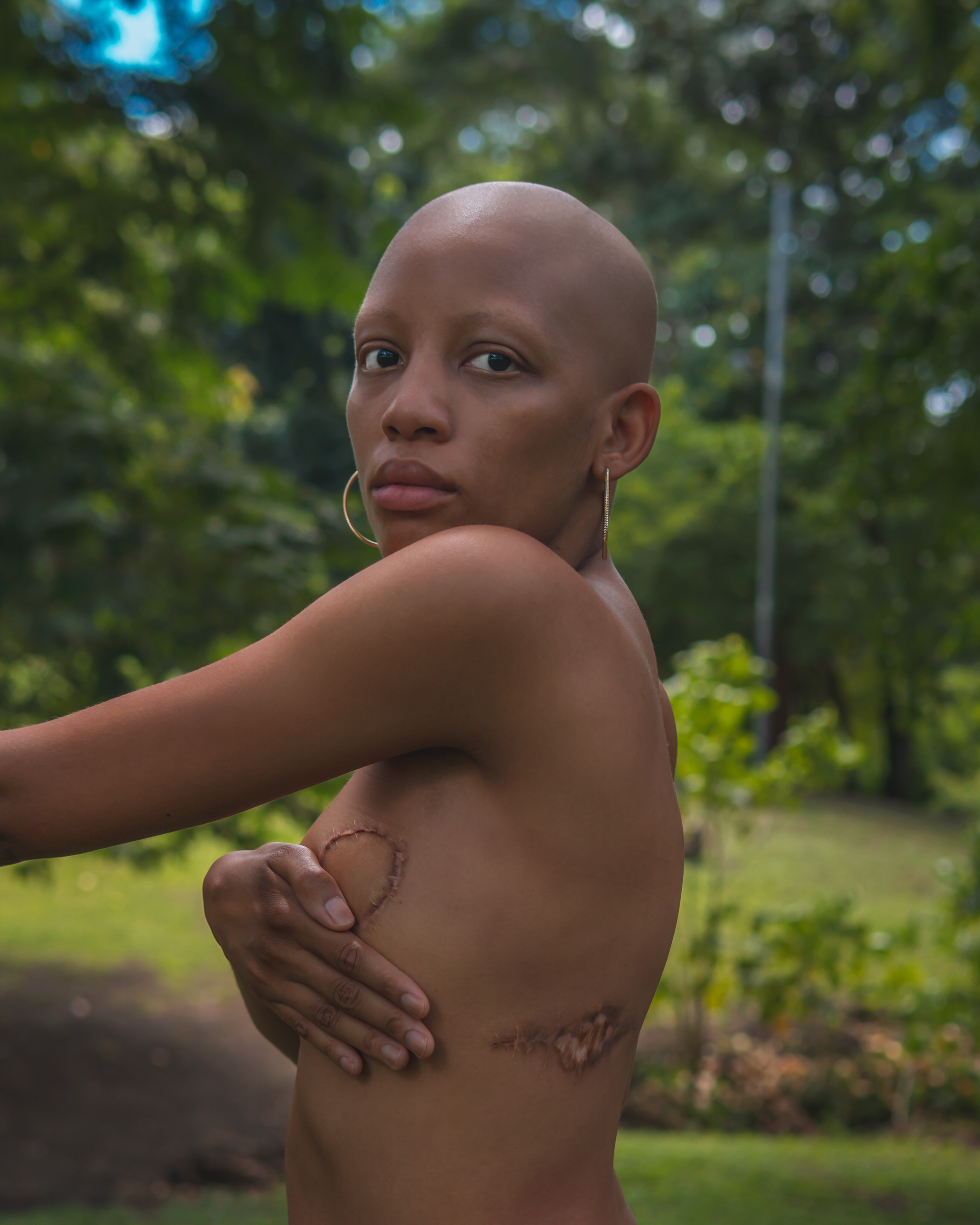A 16-year-old Sadé Weekes sat in rapt attention during a Health Education class at Debe High School in South Trinidad. It was 2006, and unbeknownst to her, she was on the verge of encountering information that would later prove life-saving. Nurses brought in for a Health Fair Day moved from class to class teaching students about the human body, as well as their sexual and reproductive health. In a segregated room, reserved for only female pupils, occupied by Sadé and others, a nurse would inform her teenage audience of the importance of conducting breast self-examinations both before and after menstrual periods. These admonitions would be followed by a demonstration of how these examinations should be conducted.
Sadé was a hearer, but she was also a doer because in 2018, she was still practicing what she had learnt at the Health Fair on that fateful day in 2006. Twelve (12) years later she was faithful in performing her breast self-examinations both before and after her menstrual periods. A dozen years later, a few weeks before her 28th birthday, her fingers would make contact with a lump: defined, hard, and foreign.
Sadé was shocked.
When I found it, it shocked me. and I immediately got anxious and scared. I immediately thought the worst because of how hard and defined the lump was.
A week after having made the dreaded discovery, Sadé would take her first definitive steps to confront the foreign mass in her left breast: she confided in her brother. A hospital employee, he would advise her to go to the emergency room. The next day, a Sunday morning, she heeded her brother’s advice.
It was a Sunday morning. I remember cause it didn’t have a lot of people in casualty.
She would leave the hospital on that Sunday with a report that would neither quell nor spark her fears. The doctor who attended to her at the emergency room didn’t know what was causing the lump and chose not to cause her too much alarm. He told her that it could be anything, but just to be safe, he wanted her to go to the breast clinic to have a biopsy done.
From DCIS to Stage IIIB Invavsive Carcinoma
The biopsy would show that Sadé’s left breast had been invaded by a High-Grade Ductal Carcinoma in Situ (DCIS)1Ductal carcinoma in situ (DCIS) means the cells that line the milk ducts of the breast have become cancer, but they have not spread into surrounding breast tissue. DCIS is considered non-invasive or pre-invasive breast cancer. DCIS can’t spread outside the breast, but it still needs to be treated because it can sometimes go on to become invasive breast cancer (which can spread). She would undergo an additional biopsy to confirm the diagnosis and if it registered another positive, she would go into surgery to have the lump removed. The result came back positive, but it would be months before she would have the required surgery. By the time all the cogs of the health system in Trinidad had joined to move in unison, Sadé’s lump had grown to 5 centimeters, requiring an even more invasive lumpectomy than she originally anticipated. She had the surgery in April 2019.

Sadé was young: 28. She still had lots of life ahead of her, so doctors wanted to rid her of the problematic lump as much as they wanted to help her to preserve her left breast. For this reason, they also performed a natural breast reconstruction using a latissiumus dorci flap (a muscle from her back) as replacement for the tissue removed. This helped to keep the shape and form of her breast, but it would come to matter very little, in the grand scheme of things.
During the lumpectomy, doctors had shaved extra margins just to be safe; to ensure that the carcinoma had been fully removed. When those extra shaved margins were tested, they too came back positive for DCIS signaling that the carcinoma had lodged itself in far more parts of Sadé’s left breast than initially pinpointed. It was a necessity for her to go back under the knife and in September 2019, she would undergo another surgery to remove the additional sightings of DCIS.
After the second surgery, Sadé and her doctors had high hopes that all of the cancerous cells had been taken out. She would go to follow up appointments to ensure that her scar was healing properly, and all seemed to be well. But a few months after the surgery, her breast begun to swell, she began to experience a pain gradually growing in its intensity and her concern grew.
At this point, her doctors were recommending a simple mastectomy. But her pain persisted, and so did she in her search to find the reason behind it. Eventually, she was sent to do an ultrasound, where she was told that the pain was the result of an abscess. She found out that the abscess was a completely inaccurate diagnosis when the doctor who would be responsible for draining it informed her that there was no indication of fluid and thus no indication that whatever was causing her pain was an abscess.
At that point, she sought answers elsewhere.
She visited a private doctor, who at first glance, could tell that the DCIS had progressed to invasive breast cancer. To confirm what his eyes could see he went on to conduct an additional ultrasound, a mammogram, and a lymph node biopsy. At the end of it, Sadé was diagnosed with Stage 3 (III)B invasive breast cancer2The tumor may be any size, AND cancer has invaded the chest wall or breast skin with evidence of swelling, inflammation, or ulcers (such as with cases like inflammatory breast cancer). The breast cancer may also have invaded up to 9 nearby lymph nodes..
Confronting Standards of Beauty & Femininity
Cancer – in any form – is not cute or dainty. There is pain, weakness, weight loss, hair loss, vomiting, and highly invasive surgeries. Breast cancer is slightly unique in that, by attaching itself to the breasts, it comprehensively clashes with, and alters the physical features that society uses to define a woman’s beauty and femininity: the curves of her hips, the fullness of her breasts, the health and flow of her hair, and the flawlessness of her skin.

According to Sadé, well before cancer made its entrance into her life she struggled with defining beauty in a manner that would favor her. Breast cancer made the conflict an even more conscious one.
Her new diagnosis of Stage 3 (III)B Invasive cancer meant that the previous surgeries were unsuccessful in curbing the progression of the carcinoma. The new diagnosis also meant that she would have to undergo chemotherapy. Chemotherapy meant, among other things, that she would lose her hair.
So for me growing up, beauty was all about having long hair, smooth skin, the perfect body shape.
I clung to that, and because I didn’t look like that because of the texture of my hair, I didn’t think I was beautiful for a very long time – even into my early twenties – so getting cancer and losing my hair devastated me far more than people know.
I honestly thought I was ugly. I would look in the mirror and cry… A lot. Not for anyone to see, though.
It was hard, but I had to now find another definition for beauty, because I didn’t fit into the world’s mould.
I had scars ony body so my skin wasn’t sexy smooth anymore. My figure was gone. My hair was gone….. I had to force myself to find out who is Sadé without the world’s frame.
This is not mentioning that Sadé was navigating these new realities in a Caribbean society where people often prioritize harsh truths over being respectful of sensitivities.
A few days ago, she shared this experience on one of her social media profiles:
Momz and I in the grocery bakery section, minding our own business happy as can be.
Momz ole fren’ (across section): “Aye Jen! How you going? Long time… ah see you with your son”
Me (son): ????…..
Brain????: Sadé hush, eh. DO NOT let yuh red gyul behavior come out!!”
Sighhhhh!!!!
But the people factor hasn’t been all bad. It was someone’s comments which led her to slowly embrace her new look.
Someone told me, “Omg…” They had no idea I was this beautiful, because losing the hair made them see all of me. After that I very slowly started to embrace my new look day by day.
Holding on To Faith
Every breast cancer patient has a unique experience with the disease. Each one deals with the diagnosis, the different stages, and the journey to remission differently. Some traverse the road with the support of ample friends and family, while others opt to go it alone. Some spend the experience predominantly in a space of depression and anxiety, while others see in a new light life, love, family and friends. Some rest firmly on religion while others neglect the notion of a good God.

Sadé’s journey has been a mix. She started off fearful, but has managed to take her life by the reins. If you shoot her a message, you may just miss her as the probability of her being in attendance at one of her classes at the University of Trinidad and Tobago is high. Two years in, when asked how she has managed to endure with such grace, positivity and resilience she speaks of her mother being her proverbial rock, her friends, and her church family but she credits her faith – her God – most.
God mainly honestly I couldn’t have gotten this far without His strength, grace and love. I lean on Him for everything now, cause He has preserved me well and kept His promises towards me.
Breast Cancer and Caribbean Women
Sadé’s journey is her own. But ’tis true that many elements of her story will pose to some a disconcerting familiarity; a breast cancer journey that is distinctly-Caribbean. It is a journey marked by fear of the unknown, inaccurate and late diagnoses, and a seeming lack of urgency by practitioners bred by an inadequate and sluggish health care system. There are also the elements which are not present in Sade’s story: the shame, the secrecy, and a fear so crippling that it compels its host not to pursue treatment options because diagnosis/detection is a death sentence.
A Morbidity and Mortality Report shows that Breast cancer is the main cause of cancer deaths among Caribbean women, accounting for 14%-30% of cancer deaths. This disease has a significant impact on women’s health and is two times higher in the Caribbean as compared to the USA3https://www.cdc.gov/mmwr/volumes/65/wr/mm6549a3.htm?s_cid=mm6549a3_w.
In 2018, Dr. Virginia Asin-Oostburg, Director, Surveillance Caribbean Public Health Agency, commented on the statistics, saying “The large number of deaths from breast cancer is very alarming since they are mostly preventable. Breast cancer can be detected early and treated successfully. It can be prevented through education, screening, early detection, accurate diagnosis and treatment”. She encouraged women “to act now to lower your chance of getting cancer. Get tested. Detection of the disease is not a death sentence. There’s a good chance of recovery if it’s detected in its early stages.”

What’s Next for Sadé?
Sadé is a couple of weeks from her 30th birthday. Her journey has been long, and full of ups and downs. She has made significant strides in beating the disease, but she’s not done yet. On September 25th, Sadé finished 16 cycles of chemotherapy. Her next order of business is a mastectomy and the removal of 2 lymph nodes. Until then, she continues to bask in a joie de vivre that urges her to take on new challenges. Like posing so vulnerably for this article.
You can support Sadé’s journey to conquering breast cancer by donating to her fundmetnt campaign or directly to her bank account using the following details:
First Citizens Bank (FCB)
Sade Kimberly J Weekes
Acc#2519728





1 comment
Inspiring journey of resilience and overcoming these unexpected life challenges. Thank you for sharing. Prayers and comfort to Sade.